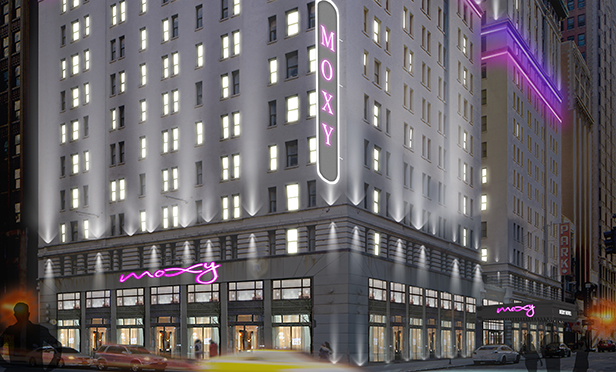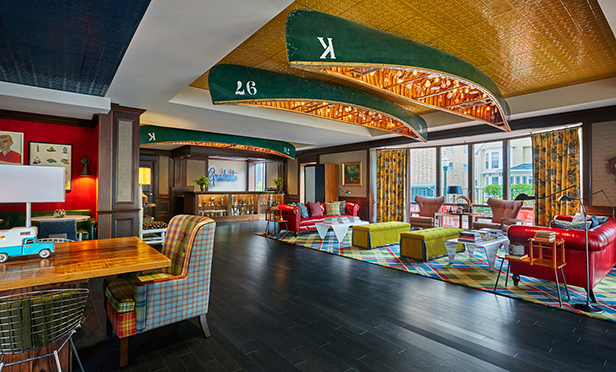
This is an HTML version of an article that ran in Real Estate Forum. To see the story in its original format, click here.
Whether playing in the schoolyard or in business, people want to be with the “in crowd.” Its members sport looks that either are in keeping with trends or are unique, they're well liked and it's assumed they're going places.
In today's hotel industry, that “cool kid” is unconventional lodging formats. More specifically, the product types that have hotel investors, owners, management companies and customers all aflutter are boutiques, lifestyle properties and select-service hotels. Much like the kids at the popular table, appearance is a key focus at these hotels (in the form of design), they're the places where travelers-in-the-know want to be and where investors want to place their capital.
Adding to their appeal—particularly in the case of select service—they're generally a better value for guests than big box or full service hotels, which makes them more cost effective for buyers. Granted, these property types aren't new, but they're on the rise.
Boutique and lifestyle hotels are a $13.7-billion industry and growing, according to a report from the Highland Group. Lifestyle hotels alone grew at a compound annual average rate of 15% between 2000 and 2015, while boutiques show supply growth at a 7% annual rate.
As per Highland's report, boutique and lifestyle formats are “poised to gain market share and become a significantly larger component of the lodging industry.”
Performance metrics for these hotel segments also are enticing. When compared to the universe of other hotels nationally, boutiques bring in a higher average daily rate as well as an increased occupancy level. In January of this year, boutiques posted an ADR of approximately $250 and about 75% occupancy on average, according to Smith Travel Research. By comparison, the other properties had an ADR of about $150 and occupancy of approximately 65%.
And it's not just the numbers spurring the success of unconventional lodging products. Enthusiasts among both investors and travelers—and there are many—each have reasons for liking these hotels, and there's no shortage of rationales, or inventory.
In recent years, Marriott has introduced Moxy Hotels, Edition and the Autograph Collection. Hilton has launched Curio, Canopy and Tru. In select service, the company also is behind Hampton Inn and Homewood Suites. Hyatt has created Hyatt Centric and, a bit longer ago but also in the lifestyle segment, Andaz.
There are smaller companies playing in the unconventional space, too, like Ace Hotels, Standard Hotels, 21c Museum Hotels and Grand Bohemian Hotels, to name a few boutique and lifestyle brands, not to mention independent hotels. The list of recently created chains and properties goes on, suggesting at least a perceived need for this type of product in the marketplace.
“Hoteliers are finding that a large segment of the population wants something different, with high quality product and great shared areas,” says Geoff Davis, partner and CIO in Leon Mayer & Co.'s hospitality real estate practice. “A large part of the public is migrating to these shared experiences that are more than a bed and a television. Now the hotel lobby is a town hall where people are having a drink and mingling, and they're on their computers, which is more enjoyable than being in the guest room.”

In particular, these property types are thought to appeal to the coveted millennial customer, who likely seeks high technology and funky places. However, the hotels also reportedly attract another generation: baby boomers. “These travelers, who if I am not mistaken number over 75 million, like hotels that are indigenous to the destination and provide unique experiences with a more communal feel,” says Evan Weiss, executive managing director and principal with LW Hospitality Advisors.
The rise of boutique and lifestyle properties also comes from society's increased connectivity. “It's a function of the ability to share information through social media,” Weiss opines. “Twenty to 30 years ago it was tougher to research things. The wealthy have always known about travel but now anyone with a computer can find out about a cool club in an unknown town in Portugal.”
Ryan Totaro, CEO and owner of NYLO, a boutique hospitality company, elaborates, “In just a few minutes, virtually anyone, anywhere, can reach into their pocket and learn what they'd want to know about a certain hotel. The ubiquity of web-enabled mobile devices has democratized this knowledge. You could be living in a desert oasis and still be fluent in hospitality design innovations and culinary trends.”
As a result, travelers are choosing to stay in places with the promise of unconventional lodging. “Guests these days are drawn to the experiential,” Totaro asserts. “They tend to value the possibility of discovery and inspiration over the excessive formality of conventional hotel service.”
Lightstone is betting big on just that mindset by developing three Moxy hotels in New York, Miami and Los Angeles. A few years back when the company set out to build some new properties, noting high land costs, relates president Mitchell Hochberg, officials asked themselves, “'Why does the guestroom have to be 350 square feet?' We wondered if it could be smaller or even half the size while providing the same experience, or a better one, that a traditional hotel offers.”
He says, “We thought about a cruise ship and a stateroom, which is thoughtfully and tastefully laid out but small, with a great bed and tasteful design. We also provide entertainment and food because there's no reason to stay in the room. Each hotel has a restaurant with a simple, varied menu where people can have a great time whether it's 9 a.m. or 9 p.m.”
Adds Ben Gottlieb, founder and CEO of AJ Capital, which owns lifestyle hotels, “Guests are willing to pay a premium for an experiential stay.” That amount varies by market but qualitatively, the company's hotels are well received—even by some surprising fans.
“When we developed the Hotel Lincoln, which we acquired as a shuttered Days Inn, we positioned the hotel as if it's a home in terms of the design and the community ate it up,” he boasts. “We created Chicago's most sought-after rooftop bar and our common areas are frequented by local residents, community members and hotel guests alike.”
The company's portfolio includes its Graduate Hotels brand, a series of lifestyle properties in university-anchored markets nationwide. Thus far, the chain includes six operating hotels and four under development.
AJ Capital turned to colleges, Gottlieb reveals, “because university markets are stable. We compared RevPAR in 40 of them to the top 25 MSAs during the last cycle and, from the peak to trough, the top markets decreased by about 20% while in university communities, they decreased by 12%. We were seeking, and are achieving, opportunistic returns.”

Lifestyle properties can be a good fit for more creative hotel buyers because “soft brands”—a category within the category that refers to a hotel chain where each property is unique—don't include stringent brand standards with which developers must comply.
That's an enticement for Leon Mayer & Co., which purchased the famed El San Juan Hotel & Resort in Puerto Rico this past July for $71 million. Following an extensive redevelopment, the hotel will become a Curio by Hilton.
“We're being given a lot of latitude by Hilton, versus being told we need to get this carpet and that headboard,” says Davis. “You can't just do anything you want, but there is a lot more flexibility on design. With the lifestyle brands, each property can tell its own story and the owner gets a better ROI by giving guests more than they expect.”
When it comes to select service, the biggest part of the value proposition is cost. The properties are cheaper to build, boosting their appeal to developers and buyers while being well positioned to offer a lower room rate than full service hotels.
“These hotels can be built for a total smaller dollar cost and they have become popular because they're easier to develop,” reveals Mark Rosinsky, chief executive officer of US Lodging Investors. “They're smaller, less complicated to construct and they can be created faster, which means less risk from the time the development starts to the property opening.”
Another reason for the success of these properties is the nature of their markets, Rosinsky suggests. “The supply in many secondary and tertiary locations is pretty old and the properties are budget facilities, so when someone comes in with a good select-service property it may be absorbed, even though there was no shortage of rooms previously. It will do well at the expense of the older properties.”
These hotels tend to succeed by catering to travelers in need of a quality guest room and little else. “There are people who don't need valet parking, a full-service restaurant or a banquet facility,” notes Hochberg.
He adds, “Hotel companies are trying to create new segments to capture the ever-changing customer. They needed to determine a new area of the market because there are only so many Hiltons and Marriotts to be built. The only way to grow is to figure out what markets you can appeal to. Plus consumers are changing and if you can figure out what they want, it's a win-win.”
But that's the $64,000 question, and all hoteliers don't agree on what product is the right answer. Some market players question the boutique buzz.
“I don't think there are intrinsic advantages and disadvantages–it's about the product, its location and the execution of the vision,” declares Weiss. “Also, investors are looking for different things; some want big-box, city-center, brand-managed hotels because they are investing for institutional buyers. Others want unencumbered, high-octane food and beverage, design and a chic factor—think opportunistic investors or those want to create or expand their own brand.”
Rosinsky questions how boutiques can compete without a key selling point of the big brand properties. “Boutiques, by definition, are the antithesis of chains but for them to grow, they become a chain,” he notes. “It's hard to be successful without a frequent guest program, but once you have one, you become more 'normative,' rather than different. It's a tricky business from a marketing standpoint.”
Others who see value in boutique and lifestyle hotels concede that marketing is key, but contend the effort is worthwhile.
“It is challenging to create your own brand, it's a bet on the Internet,” admits Seth Schumer, head of US investments at Quadrum Global. “You have to do revenue management and marketing and hope to grab good reviews on Trip Advisor.”

For Quadrum—which has three hotel development sites in New York City, two properties in Chicago and assets throughout Florida—the decision to create boutique properties was made after the company discovered what it felt were some onerous rules of engagement with the larger companies.
“For our hotel in Orlando, when we saw what it would cost to be a part of a brand's reservation system and what we'd have to pay in commissions to the online travel agencies, it wasn't worth it,” reveals Schumer.
“We have more flexibility with a smaller company if they don't perform,” he continues. “Then we can sell the hotel unencumbered, which is attractive to REITs or someone who has a brand and wants to be in a market where we have a hotel. They can buy our property and brand it anything they want.”
To get that purchasing power, many hotel buyers and investors need financing. In the current market, while there's an education process, procuring capital hasn't been a problem for most players.
“The banks and financial institutions we've been talking to are eager to learn about new brands; they just need more comprehensive market data than that of more traditional hotel types,” says Hochberg. “Select-service hotels are probably the easiest to finance because they're just a rooms business, we're not trying to project F&B revenue.”
“You have to convince the lenders that this is the right brand,” explains Schumer. “You have to show them the concept, and that only works in some cities. I would expect lenders to be cautious but to feel safe in strong hotel markets where their collateral would maintain its value and be attractive to other hotel operators and brands.”
But it's up to the hoteliers to keep these unconventional lodging segments alive. “The hospitality companies that win will be those on the pulse of the dynamic shifts in consumer behavior and who can position themselves to benefit from them,” asserts Totaro.
The trick, suggests Weiss, is to design not just for now, but for the future, too. “Your FF&E—both design-wise and physically—should last over 10 years, and the functionality of the properties should be paramount.”
He advises hoteliers, “Think about the future, and think about your design decisions with ROI considerations. At the end of the day, the hotel experience can be great, but experiences must drive returns for investors as well.”
SIDEBAR: What's In a Name?
How one defines these different product types seems to depend largely on what market is being discussed and, frankly, on who is asked to offer up a definition.
However, in a paper on boutique and lifestyle hotels, David Jones, Jonathon Day and Donna Quadri-Felitti of the hospitality departments at, respectively, the University of San Francisco, Purdue University and formerly New York University (now at Penn State), provided the following definitions of the two segments:
“Boutique hotels are typically small hotels that offer high levels of service. They tend to be stylish, trendy and 'cool,' and provide an intimate hotel experience. They are unique and often provide authentic cultural or historic experiences and interesting services to guests.
“Lifestyle hotels tend to be small- to medium-sized hotels that provide innovative features and service as well as contemporary design. They provide highly personalized service that differentiates them from larger hotel brands.”
Meanwhile, Smith Travel Research's Jan Freitag tells Real Estate Forum, “Select service refers to hotels that don't have a ballroom, possess almost no meeting space and feature limited food and beverage offerings or even none at all.”

This is an HTML version of an article that ran in Real Estate Forum. To see the story in its original format, click here.
Whether playing in the schoolyard or in business, people want to be with the “in crowd.” Its members sport looks that either are in keeping with trends or are unique, they're well liked and it's assumed they're going places.
In today's hotel industry, that “cool kid” is unconventional lodging formats. More specifically, the product types that have hotel investors, owners, management companies and customers all aflutter are boutiques, lifestyle properties and select-service hotels. Much like the kids at the popular table, appearance is a key focus at these hotels (in the form of design), they're the places where travelers-in-the-know want to be and where investors want to place their capital.
Adding to their appeal—particularly in the case of select service—they're generally a better value for guests than big box or full service hotels, which makes them more cost effective for buyers. Granted, these property types aren't new, but they're on the rise.
Boutique and lifestyle hotels are a $13.7-billion industry and growing, according to a report from the Highland Group. Lifestyle hotels alone grew at a compound annual average rate of 15% between 2000 and 2015, while boutiques show supply growth at a 7% annual rate.
As per Highland's report, boutique and lifestyle formats are “poised to gain market share and become a significantly larger component of the lodging industry.”
Performance metrics for these hotel segments also are enticing. When compared to the universe of other hotels nationally, boutiques bring in a higher average daily rate as well as an increased occupancy level. In January of this year, boutiques posted an ADR of approximately $250 and about 75% occupancy on average, according to Smith Travel Research. By comparison, the other properties had an ADR of about $150 and occupancy of approximately 65%.
And it's not just the numbers spurring the success of unconventional lodging products. Enthusiasts among both investors and travelers—and there are many—each have reasons for liking these hotels, and there's no shortage of rationales, or inventory.
In recent years, Marriott has introduced Moxy Hotels, Edition and the Autograph Collection. Hilton has launched Curio, Canopy and Tru. In select service, the company also is behind Hampton Inn and Homewood Suites. Hyatt has created Hyatt Centric and, a bit longer ago but also in the lifestyle segment, Andaz.
There are smaller companies playing in the unconventional space, too, like Ace Hotels, Standard Hotels, 21c Museum Hotels and Grand Bohemian Hotels, to name a few boutique and lifestyle brands, not to mention independent hotels. The list of recently created chains and properties goes on, suggesting at least a perceived need for this type of product in the marketplace.
“Hoteliers are finding that a large segment of the population wants something different, with high quality product and great shared areas,” says Geoff Davis, partner and CIO in Leon Mayer & Co.'s hospitality real estate practice. “A large part of the public is migrating to these shared experiences that are more than a bed and a television. Now the hotel lobby is a town hall where people are having a drink and mingling, and they're on their computers, which is more enjoyable than being in the guest room.”

In particular, these property types are thought to appeal to the coveted millennial customer, who likely seeks high technology and funky places. However, the hotels also reportedly attract another generation: baby boomers. “These travelers, who if I am not mistaken number over 75 million, like hotels that are indigenous to the destination and provide unique experiences with a more communal feel,” says Evan Weiss, executive managing director and principal with LW Hospitality Advisors.
The rise of boutique and lifestyle properties also comes from society's increased connectivity. “It's a function of the ability to share information through social media,” Weiss opines. “Twenty to 30 years ago it was tougher to research things. The wealthy have always known about travel but now anyone with a computer can find out about a cool club in an unknown town in Portugal.”
Ryan Totaro, CEO and owner of NYLO, a boutique hospitality company, elaborates, “In just a few minutes, virtually anyone, anywhere, can reach into their pocket and learn what they'd want to know about a certain hotel. The ubiquity of web-enabled mobile devices has democratized this knowledge. You could be living in a desert oasis and still be fluent in hospitality design innovations and culinary trends.”
As a result, travelers are choosing to stay in places with the promise of unconventional lodging. “Guests these days are drawn to the experiential,” Totaro asserts. “They tend to value the possibility of discovery and inspiration over the excessive formality of conventional hotel service.”
Lightstone is betting big on just that mindset by developing three Moxy hotels in
He says, “We thought about a cruise ship and a stateroom, which is thoughtfully and tastefully laid out but small, with a great bed and tasteful design. We also provide entertainment and food because there's no reason to stay in the room. Each hotel has a restaurant with a simple, varied menu where people can have a great time whether it's 9 a.m. or 9 p.m.”
Adds Ben Gottlieb, founder and CEO of AJ Capital, which owns lifestyle hotels, “Guests are willing to pay a premium for an experiential stay.” That amount varies by market but qualitatively, the company's hotels are well received—even by some surprising fans.
“When we developed the Hotel Lincoln, which we acquired as a shuttered Days Inn, we positioned the hotel as if it's a home in terms of the design and the community ate it up,” he boasts. “We created Chicago's most sought-after rooftop bar and our common areas are frequented by local residents, community members and hotel guests alike.”
The company's portfolio includes its Graduate Hotels brand, a series of lifestyle properties in university-anchored markets nationwide. Thus far, the chain includes six operating hotels and four under development.
AJ Capital turned to colleges, Gottlieb reveals, “because university markets are stable. We compared RevPAR in 40 of them to the top 25 MSAs during the last cycle and, from the peak to trough, the top markets decreased by about 20% while in university communities, they decreased by 12%. We were seeking, and are achieving, opportunistic returns.”

Lifestyle properties can be a good fit for more creative hotel buyers because “soft brands”—a category within the category that refers to a hotel chain where each property is unique—don't include stringent brand standards with which developers must comply.
That's an enticement for Leon Mayer & Co., which purchased the famed El San Juan Hotel & Resort in Puerto Rico this past July for $71 million. Following an extensive redevelopment, the hotel will become a Curio by Hilton.
“We're being given a lot of latitude by Hilton, versus being told we need to get this carpet and that headboard,” says Davis. “You can't just do anything you want, but there is a lot more flexibility on design. With the lifestyle brands, each property can tell its own story and the owner gets a better ROI by giving guests more than they expect.”
When it comes to select service, the biggest part of the value proposition is cost. The properties are cheaper to build, boosting their appeal to developers and buyers while being well positioned to offer a lower room rate than full service hotels.
“These hotels can be built for a total smaller dollar cost and they have become popular because they're easier to develop,” reveals Mark Rosinsky, chief executive officer of US Lodging Investors. “They're smaller, less complicated to construct and they can be created faster, which means less risk from the time the development starts to the property opening.”
Another reason for the success of these properties is the nature of their markets, Rosinsky suggests. “The supply in many secondary and tertiary locations is pretty old and the properties are budget facilities, so when someone comes in with a good select-service property it may be absorbed, even though there was no shortage of rooms previously. It will do well at the expense of the older properties.”
These hotels tend to succeed by catering to travelers in need of a quality guest room and little else. “There are people who don't need valet parking, a full-service restaurant or a banquet facility,” notes Hochberg.
He adds, “Hotel companies are trying to create new segments to capture the ever-changing customer. They needed to determine a new area of the market because there are only so many Hiltons and Marriotts to be built. The only way to grow is to figure out what markets you can appeal to. Plus consumers are changing and if you can figure out what they want, it's a win-win.”
But that's the $64,000 question, and all hoteliers don't agree on what product is the right answer. Some market players question the boutique buzz.
“I don't think there are intrinsic advantages and disadvantages–it's about the product, its location and the execution of the vision,” declares Weiss. “Also, investors are looking for different things; some want big-box, city-center, brand-managed hotels because they are investing for institutional buyers. Others want unencumbered, high-octane food and beverage, design and a chic factor—think opportunistic investors or those want to create or expand their own brand.”
Rosinsky questions how boutiques can compete without a key selling point of the big brand properties. “Boutiques, by definition, are the antithesis of chains but for them to grow, they become a chain,” he notes. “It's hard to be successful without a frequent guest program, but once you have one, you become more 'normative,' rather than different. It's a tricky business from a marketing standpoint.”
Others who see value in boutique and lifestyle hotels concede that marketing is key, but contend the effort is worthwhile.
“It is challenging to create your own brand, it's a bet on the Internet,” admits Seth Schumer, head of US investments at Quadrum Global. “You have to do revenue management and marketing and hope to grab good reviews on Trip Advisor.”

For Quadrum—which has three hotel development sites in
“For our hotel in Orlando, when we saw what it would cost to be a part of a brand's reservation system and what we'd have to pay in commissions to the online travel agencies, it wasn't worth it,” reveals Schumer.
“We have more flexibility with a smaller company if they don't perform,” he continues. “Then we can sell the hotel unencumbered, which is attractive to REITs or someone who has a brand and wants to be in a market where we have a hotel. They can buy our property and brand it anything they want.”
To get that purchasing power, many hotel buyers and investors need financing. In the current market, while there's an education process, procuring capital hasn't been a problem for most players.
“The banks and financial institutions we've been talking to are eager to learn about new brands; they just need more comprehensive market data than that of more traditional hotel types,” says Hochberg. “Select-service hotels are probably the easiest to finance because they're just a rooms business, we're not trying to project F&B revenue.”
“You have to convince the lenders that this is the right brand,” explains Schumer. “You have to show them the concept, and that only works in some cities. I would expect lenders to be cautious but to feel safe in strong hotel markets where their collateral would maintain its value and be attractive to other hotel operators and brands.”
But it's up to the hoteliers to keep these unconventional lodging segments alive. “The hospitality companies that win will be those on the pulse of the dynamic shifts in consumer behavior and who can position themselves to benefit from them,” asserts Totaro.
The trick, suggests Weiss, is to design not just for now, but for the future, too. “Your FF&E—both design-wise and physically—should last over 10 years, and the functionality of the properties should be paramount.”
He advises hoteliers, “Think about the future, and think about your design decisions with ROI considerations. At the end of the day, the hotel experience can be great, but experiences must drive returns for investors as well.”
SIDEBAR: What's In a Name?
How one defines these different product types seems to depend largely on what market is being discussed and, frankly, on who is asked to offer up a definition.
However, in a paper on boutique and lifestyle hotels, David Jones, Jonathon Day and Donna Quadri-Felitti of the hospitality departments at, respectively, the University of San Francisco, Purdue University and formerly
“Boutique hotels are typically small hotels that offer high levels of service. They tend to be stylish, trendy and 'cool,' and provide an intimate hotel experience. They are unique and often provide authentic cultural or historic experiences and interesting services to guests.
“Lifestyle hotels tend to be small- to medium-sized hotels that provide innovative features and service as well as contemporary design. They provide highly personalized service that differentiates them from larger hotel brands.”
Meanwhile, Smith Travel Research's Jan Freitag tells Real Estate Forum, “Select service refers to hotels that don't have a ballroom, possess almost no meeting space and feature limited food and beverage offerings or even none at all.”
© Touchpoint Markets, All Rights Reserved. Request academic re-use from www.copyright.com. All other uses, submit a request to [email protected]. For more inforrmation visit Asset & Logo Licensing.







